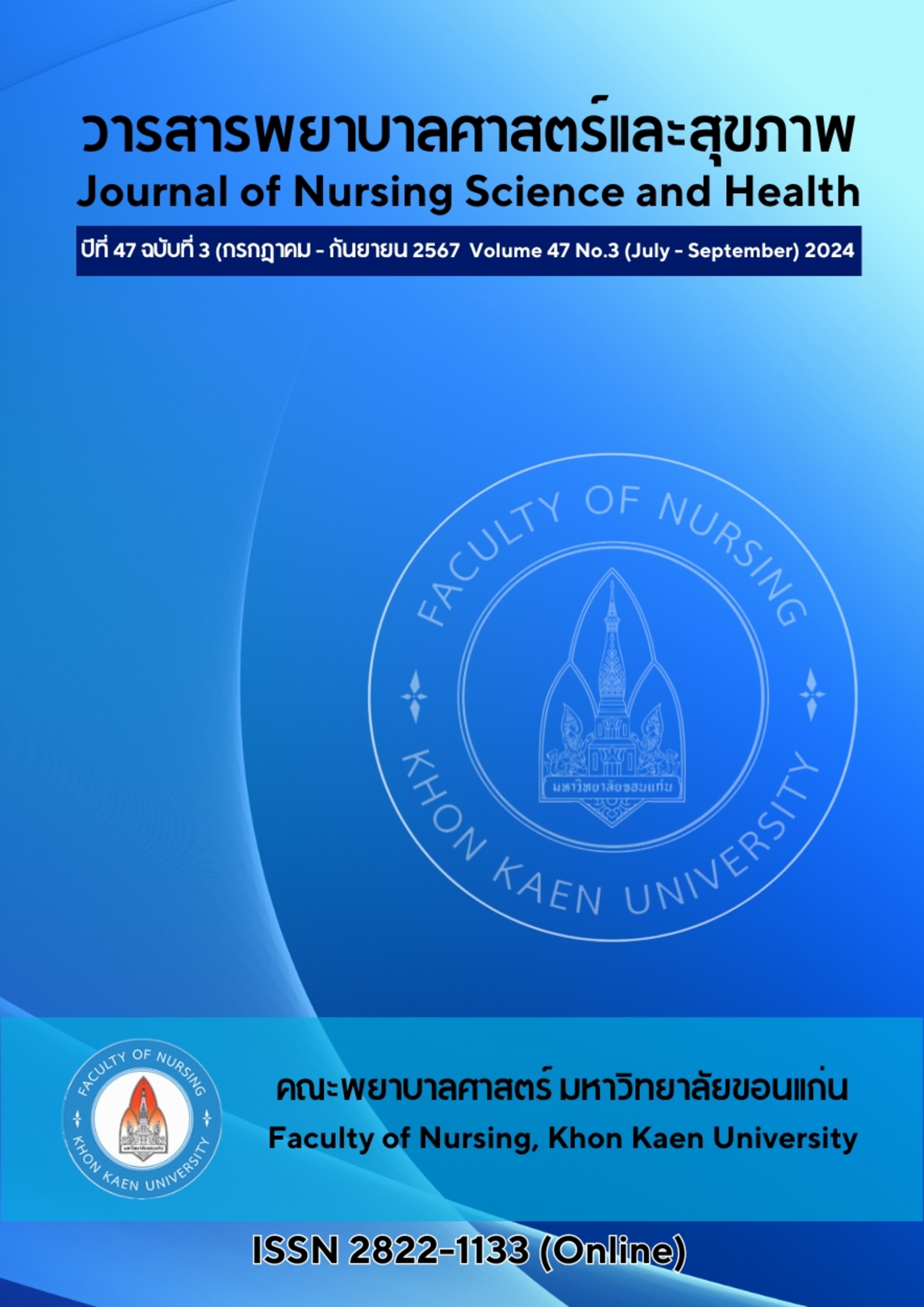ผลของการใช้เทคนิคเพื่อนช่วยเพื่อนต่ออัตราการทำความสะอาดมือของบุคลากร งานการพยาบาลผู้ป่วยพิเศษเฉพาะทาง โรงพยาบาลมหาราชนครเชียงใหม่
คำสำคัญ:
การทำความสะอาดมือ , เทคนิคเพื่อนช่วยเพื่อนบทคัดย่อ
การทำความสะอาดมือ เป็นวิธีการสำคัญในการป้องกันและควบคุมการติดเชื้อในโรงพยาบาล ซึ่งการส่งเสริมการทำความสะอาดมือมีหลายวิธี เทคนิคเพื่อนช่วยเพื่อนถูกนำมาใช้แล้วได้ผลดี ในการส่งเสริมการปฏิบัติของบุคคลในด้านต่าง ๆ การวิจัยกึ่งทดลองครั้งนี้ มีวัตถุประสงค์เพื่อศึกษาผลของการใช้เทคนิคเพื่อนช่วยเพื่อนต่ออัตราการทำความสะอาดมือของบุคลากร งานการพยาบาลผู้ป่วยพิเศษเฉพาะทาง โรงพยาบาลมหาราชนครเชียงใหม่ โดยวัดจากการเปรียบเทียบอัตราการทำความสะอาดมือของบุคลากร ก่อนและหลังการดำเนินการเดือนที่ 1, 3 และ 6 ประชากรในการศึกษาครั้งนี้ ได้แก่ บุคลากรทางการพยาบาลที่ให้การดูแลผู้ป่วยของงานการพยาบาลผู้ป่วยพิเศษเฉพาะทาง 5 หอผู้ป่วย จำนวน 133 คน ที่ปฏิบัติงานระหว่างวันที่ 1 พฤษภาคม -31 ธันวาคม 2564
เครื่องมือที่ใช้ในการดำเนินงานวิจัย ได้แก่ คู่มือการใช้เทคนิคเพื่อนช่วยเพื่อนและสมุดบันทึก เครื่องมือที่ใช้ในการเก็บรวบรวมข้อมูล ได้แก่ แบบสอบถามข้อมูลทั่วไปและแบบสังเกตการทำความสะอาดมือ เครื่องมือวิจัยนี้ผ่านการตรวจสอบจากผู้ทรงคุณวุฒิด้านเนื้อหา จำนวน 3 ท่าน ได้ค่าความตรงตามเนื้อหา เท่ากับ 1.0 การตรวจสอบค่าความเชื่อมั่นของการสังเกตระหว่างผู้วิจัยและผู้ร่วมวิจัย ได้ค่าเท่ากับ 1.0 การวิเคราะห์ข้อมูลทั่วไป โดยใช้การแจกแจงความถี่ ค่าร้อยละ และค่าเฉลี่ย ส่วนข้อมูลการทำความสะอาดมือ ในเดือนที่ 1, 3 และ 6 วิเคราะห์โดยการนำอัตราการทำความสะอาดมือมาเปรียบเทียบ โดยใช้สถิติบรรยาย
ผลการศึกษาเปรียบเทียบอัตราการทำความสะอาดมือ ในเดือนที่ 1, 3 และ 6 ก่อนและหลังใช้เทคนิคเพื่อนช่วยเพื่อน พบว่า มีอัตราการทำความสะอาดเพิ่มขึ้น โดยเฉพาะในกิจกรรมก่อนสัมผัสผู้ป่วย ผลการวิจัยครั้งนี้ให้ข้อเสนอแนะว่า การใช้เทคนิคเพื่อนช่วยเพื่อนสามารถส่งเสริมการทำความสะอาดมือของบุคลากรซึ่งจะช่วยลดการติดเชื้อในโรงพยาบาลที่เกิดจากการสัมผัสโดยมือได้
เอกสารอ้างอิง
Unahalekhaka A. Epidemiology and evidence-based practice guideline in prevention of hospital-associated infection [Internet]. Chiang Mai: Mingmuang printing house 2013. (in Thai)
World Health Organization. Recommendations to Member States to improve hand hygiene practices to help prevent the transmission of the COVID-19 virus [Internet]. Geneva: WHO; 2020[updated 2020; cited 2024 August 1]. Available from: https://www.who.int/publications/i/item/recommendations-to-member-states-to-improve-hand-hygiene-practices-to-help-prevent-the-transmission-of-the-covid-19-virus
Chhapola V, Brar R. Impact of an educational intervention on hand hygiene compliance and infection rate in a developing country neonatal intensive care unit. Int J Nurs Pract 2015;21(5):486-92.
World Health Organization. WHO guidelines on hand hygiene in health care: First global patient safety challenge clean care is safer care; 2009. Retrieved from: http://www.who.int/gpsc/whqlibdoc.who.int/publications/2009eng.pdf
World Health Organization. Campaign guide for engaging in World Hand Hygiene Day 5 May 2023. Retrieved from: https://www.who.int/campaigns/world-hand-hygiene-day/2023
World Health Organization. WHO guidelines on hand hygiene in health care (advance draft). Switzerland: Imprimerie Genevoise SA.; 2007.
Pittet D. Improving compliance with hand hygiene in hospitals. Infect Control Hosp Epidemiol 2000;21:381-6.
Mikey K, Picheansathian W, Boonchuang P. Effects of multimodal hand hygiene improvement strategies on knowledge and practices of hand hygiene among healthcare personnel. Nursing J 2016;43(2):68-78. (in Thai)
Infection prevention and control work Nursing Department Maharaj Nakorn Chiang Mai Hospital. Performance report for the year 2020.
Topping K, Ethy S, editors. Peer-assist learning. New York: Routledge; 2009.
Williams B, Reddy P. Does peer-assisted learning improve academic performance? A scoping reviews. Nurse Educ Today 2016;42:23-9.
Srisomphan K, Sirisakulpaisarn B, Bormann SV. Peer-assisted learning strategy in return-demonstration exam for mechanism of labor. J Hlth Sci Res 2017;11(2):138-46. (in Thai)
Barret R, Randle J. Hand hygiene practices: nursing students’ perceptions. J Clin Nurs 2008;17:1851-7.
Watthanawong S. Psychology for training adults. Bangkok: We print; 2012. (in Thai)
Phornphibul P. Implementation research: competencies of advanced practice nurses. TJNMP 2019;6(2):5-15. (in Thai)
Suwansuntorn P, Promwigorn A. Factors affecting the behavior of hand washing decisions to prevent and control infection on the personnel of a community hospital, Songkhla province case study: Namom hospital. Maharaj Nakhon Si Thammarat Medical Journal 2019;3(1):1-9. (in Thai)
Mahapasuthanon W. A comparison study of hand-wash rate of medical personnel before and after automatic hand-wash detector usage in medical intensive care unit, King Chulalongkorn Memorial Hospital [Dissertation]. Bangkok: Chulalongkorn Univ; 2022. (in Thai)
Jandaeng B, Kosolkittiamporn S, Kenaphoom S. Factors that affecting behavior change. DAJ 2019;19(4):235-44. (in Thai)
Onsaard C, Klunklin P, Senaratana W. Effects of the prevention and control program for methicillin-resistant staphylococcus aureus on knowledge and practices among nurses in neonatal intensive care unit. Nursing J 2012;39(2):51-65. (in Thai)
Sisuksai N, Lertwatthanawilat W, Unahalekhaka A. Effects of education provision and feedback on practices for prevention of multidrug-resistant organisms among nurses. Nursing J 2021;48(3):141-53. (in Thai)
Tappen RM, Weiss SA, Whitehead DK. Giving and receiving feedback. In essentials of nursing leadership and management. 3rd ed. Philadelphia: F.A. Davis; 2004
Rojanapriboon A. Teaching materials human behavior course for personal development. Bueng Kan Educational Center Udon Thani Rajabhat University; 2018. (in Thai)
Van FD, Peterson TO. Contemporary management. 3rd et. Boston: Houghto Miffin; 1994.
Walker JL, Sistrunk WW, Higginbotham MA, Burks K, Halford L, Goddard L, et al. Hospital hand hygiene compliance improves with increased monitoring and immediate feedback. Am J Infect Control 2014;42(10):1074-8.
Chaiyapan M. Psychology: theory concept in a study of behavioral modification in the classroom. pnujr huso 2014;11(1):21-33. (in Thai)
Thammasarorat R. Kalyanamit and the concept of changing health behavior. MGSJ 2019;14(2):56–65. (in Thai)
ดาวน์โหลด
เผยแพร่แล้ว
รูปแบบการอ้างอิง
ฉบับ
ประเภทบทความ
สัญญาอนุญาต
ลิขสิทธิ์ (c) 2024 วารสารพยาบาลศาสตร์และสุขภาพ

อนุญาตภายใต้เงื่อนไข Creative Commons Attribution-NonCommercial-NoDerivatives 4.0 International License.
วารสารพยาบาลศาสตร์และสุขภาพเป็นเจ้าของลิขสิทธิ์ในการเผยแพร่ผลงานที่ตีพิมพ์ห้ามผู้ใดนำบทความที่ได้รับการตีพิมพ์ในวารสารพยาบาลศาสตร์และสุขภาพไปเผยแพร่ในลักษณะต่าง ๆ ดังนี้ การนำบทความไปเผยแพร่ออนไลน์ การถ่ายเอกสารบทความเพื่อกิจกรรมที่ไม่ใช่การเรียนการสอน การส่งบทความไปตีพิมพ์เผยแพร่ที่อื่น ยกเว้นเสียแต่ได้รับอนุญาตจากวารสารพยาบาลศาสตร์และสุขภาพ



